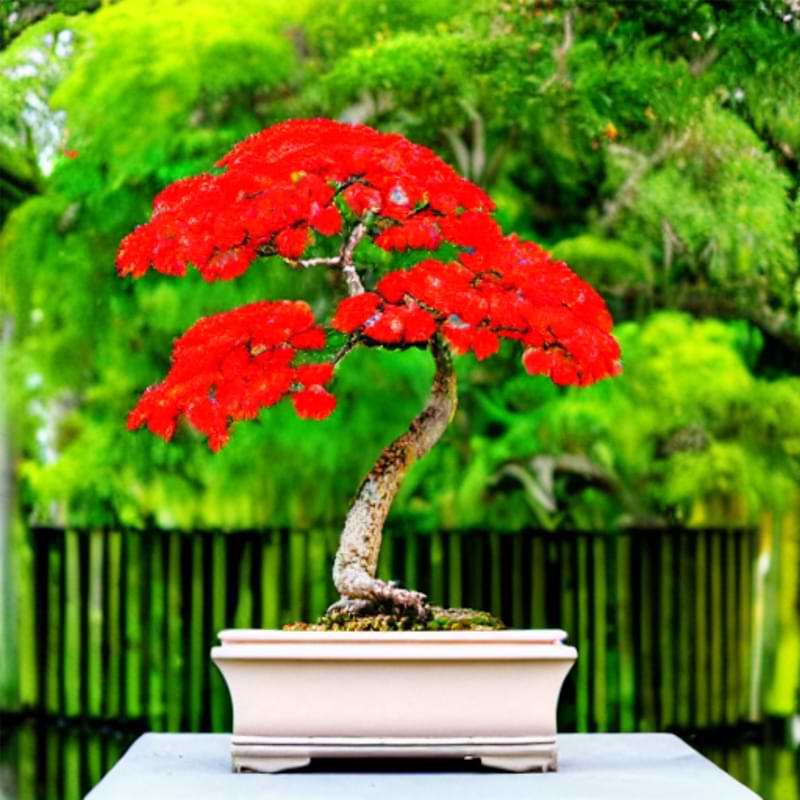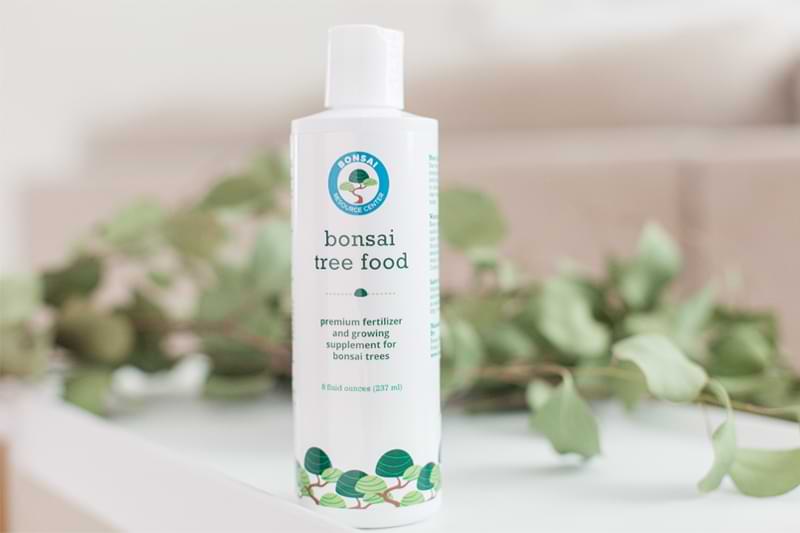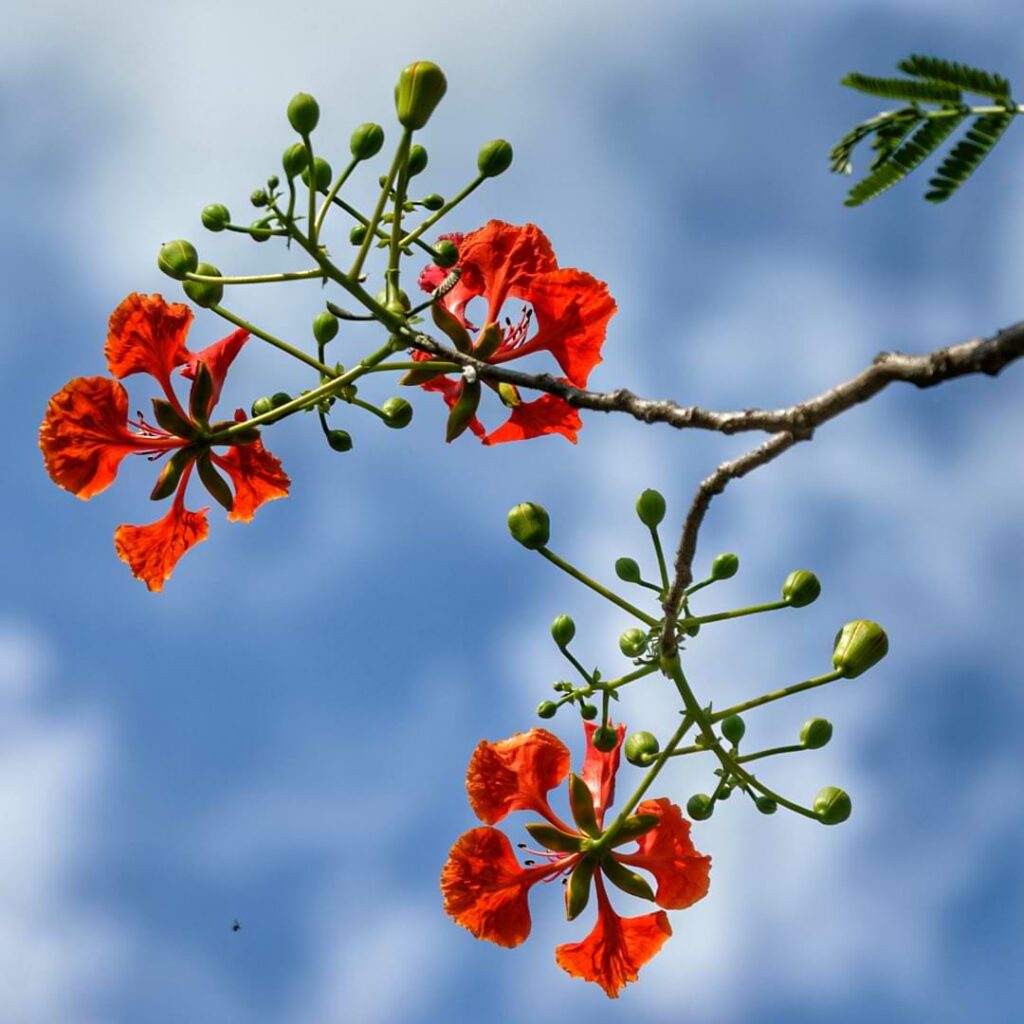The Royal Poinciana bonsai, also known as Delonix Regia, is a beautiful tropical tree that is native to Madagascar. Its large bright red and orange flowers, broad and fern-like foliage make it an attractive choice for those looking for an exotic and showy bonsai tree.
However, caring for the royal poinciana bonsai can be a challenge. In this guide we’ll provide you with all the essential information you need to know about Flame Tree care and growing so that you can have success with your Royal Poinciana bonsai!
Why Royal Poinciana Bonsai Makes a Good Bonsai
Royal Poinciana tree is a particularly good choice for those looking to create a beautiful bonsai. It is known for its beautiful, vibrant flowers that can add a lot of visual interest to your bonsai display.
The tree has relatively small leaves, which makes it easier to shape and prune into the desired bonsai form. Additionally, the Royal Poinciana is native to tropical climates, so it is well-suited for growing indoors in most cases.
Overall, the Royal Poinciana is an excellent tree species to use for creating a bonsai display. If you’re looking for a tree that will add some beauty and visual interest to your home or office, this is definitely one to consider!
Royal Poinciana Growth Rate
The Royal Poinciana tree can grow anywhere from two to five feet per year! Since it is such a fast growing tree, many people love using it as a bonsai tree because you’ll get the satisfaction of seeing the tree grow rather quickly compared to other bonsai tree varieties.
This is also why it’s incredibly important to stay on top of the proper pruning and care of your tree to ensure it doesn’t outgrow your space.

Royal Poinciana Bonsai Tree Care
As with any bonsai tree, the first step in caring for your Royal Poinciana bonsai is to choose the right pot. The pot should be shallow and wide, with good drainage. After you have the perfect pot for your bonsai tree, you’ll need to get the proper soil, find the perfect spot for it, and get it a good drink of water. Keep reading for more information on everything you’ll need to know to care for your Royal Poinciana bonsai tree.
Soil
Bonsai trees do best in well-drained soil with a pH between 6.0 and 7.5. Because the roots of this tree are relatively shallow, you’ll want to make sure the pot you choose isn’t too deep. The best soil for this tree would be a bonsai potting mix that already has the perfect mix of organic matter and soil to nourish your tree.
Position & Temperature
Position your tree in an area that receives full sun and warm temperatures – between 60 and 85 degrees Fahrenheit – as this tree is native to tropical climates.
Finally, if you live in an area with high humidity, you’ll need to take extra care to ensure your bonsai doesn’t become too wet. The best way to do this is to position it on a raised platform or shelves where the air can circulate around it.
Indoor or Outdoor Growing
If you live in a tropical or subtropical climate, you can grow Royal Poinciana bonsai outdoors all year round. If you live in a temperate climate, it’s best to grow your tree indoors.
When growing Royal Poinciana bonsai indoors, make sure to place your tree near a bright window where it will get plenty of sunlight. If possible, place the tree outside during the warm months so it can enjoy some time in the fresh air and sunshine.
To keep your indoor bonsai tree healthy, make sure to follow all care instructions, including proper watering and fertilizing to help it thrive indoors.
Water
The Royal Poinciana tree is a tropical tree that loves the heat and humidity. It’s important to make sure that your tree is getting enough water, especially during the summer months. Water your tree deeply, about once a week, and make sure that the soil is always moist but not soggy. If you live in a dry climate, you may need to water your tree more often.
During the winter months, you can reduce watering to every other week or even less often if your tree is dormant. Be careful not to let the soil dry out completely, as this can damage the roots. If you’re not sure whether or not your tree needs water, feel the soil before watering – if it’s dry several inches down, it’s time to give your tree a drink!

Fertilizing
Fertilizing your Royal Poinciana bonsai is important to maintain its health and vigor. Fertilize every two weeks during the growing season with a balanced fertilizer such as 10-10-10. Reduce fertilizer application to once a month during the winter months. Avoid over-fertilizing, which can damage the roots and leaves of your bonsai.
Alternatively, many bonsai growers prefer to feed their bonsai trees with our Bonsai Plant Food that you can give every time you water your bonsai. This gives your tree a small amount of nutrients more frequently than regular fertilizing every now and then.
Flowers
Flowers are one of the most beautiful and important features of the Royal Poinciana tree. They provide not only a splash of color and beauty to the tree, but also play an important role in its reproduction. The flowers are large and showy, typically red or orange in color with yellow stamens. They grow in clusters at the ends of branches and bloom from late spring through summer.
Each flower is made up of five petals that are fused together at the base. The flowers are pollinated by bees and other insects who are attracted to their nectar. Once pollinated, the flowers will turn into seed pods that contain numerous seeds. These seeds will eventually germinate and grow into new Royal Poinciana trees.
If your tree is kept indoors, it won’t get pollinated. That’s no big deal as long as you’re not hoping to get new seeds to grow more trees from. If you want your tree to produce seeds that will grow into more trees, you’ll need to place it outside while flowering and allow the bees to pollinate it.
Re Potting
When your Royal Poinciana bonsai tree is starting to outgrow its current pot, it’s time to repot it. This process will give your tree a chance to get some new, fresh soil and also help control its size. Here’s what you’ll need to do:
- Choose a new pot that is 1-2 inches wider and deeper than the old one. Make sure there are drainage holes in the bottom.
- Carefully remove your tree from its old pot and loosen any roots that are tightly bound.
- Place the tree in the new pot and fill in around it with fresh, well-draining bonsai tree soil. Water thoroughly.
- Place the pot in a bright spot out of direct sunlight and wait for new growth to appear.
Flame Tree Bonsai Shaping And Maintenance
Shaping and maintaining your Royal Poinciana bonsai tree is not difficult, but it does take some patience and time. You will need to prune your tree regularly to encourage new growth and keep it in the desired shape. Wire may also be used to help train the branches into the desired position. Between pruning and wiring, you will be able to train your bonsai tree into any shape you want!
Pruning
Pruning is an important part of caring for a Royal Poinciana bonsai. Pruning helps to maintain the tree’s shape and size, and can also help to control the tree’s growth.
There are two main types of pruning that can be done on a Royal Poinciana bonsai: thinning out and shaping. Thinning out is when you remove entire branches from the tree. This is usually done to help improve the tree’s overall shape or to reduce its size. Shaping is when you cut back individual branches to create a desired shape. This is often done to help improve the tree’s aesthetics or to make it easier to care for.
Pruning should be done with care, as improper pruning can damage the tree. Always use clean, sharp tools when pruning, and make sure not to over-prune the tree.
Training
To train your Royal Poinciana bonsai, you will need to prune it regularly. The best time to prune is in early spring, before new growth begins. You can also prune in late summer or early fall, after the leaves have fallen.
When pruning, be sure to remove any dead or dying branches first. Next, cut back any branches that are growing too long or too vigorously. Finally, shape the remaining branches as desired.
Training your tree will get easier as you get to know your tree and as you get more experience doing it. Just remember not to prune too heavily, even if you want to train it quickly. Good things take time, and training your bonsai tree is no different.
Wiring
Bonsai trees are often considered to be works of art, and as such, they can be quite delicate. It is important to take care when wiring your bonsai tree, as too much pressure or incorrect placement can damage the tree.
When wiring a bonsai tree, start by gently wrapping the wire around the trunk or branch that you wish to shape. Be sure not to wrap the wire too tightly, as this can cut into the bark and damage the tree. Once you have wrapped the wire around the trunk or branch, use your fingers to gently shape the tree into the desired position.
It is important to check on your bonsai tree regularly after wiring it, as the wire can cut into the bark if left in place for too long. If you see any signs of damage, such as bruising or discoloration, remove the wire immediately. With proper care and attention, your bonsai tree will thrive and continue to be a beautiful work of art for many years to come.
Royal Poinciana Bonsai FAQ
Why is my Royal Poinciana Bonsai losing leaves?
There are a few reasons why your Royal Poinciana Bonsai might be losing leaves. One possibility is that the tree is not getting enough water. Make sure to check the soil regularly and water the tree when the soil is dry. Another possibility is that the tree is not getting enough sunlight. Royal Poincianas need at least six hours of sunlight per day to thrive. If the tree is not getting enough sunlight, it will start to lose leaves. Finally, Royal Poincianas are susceptible to a number of pests and diseases. If you see any pests on the leaves or branches of the tree, treat them immediately with an appropriate pesticide or fungicide.
How long does it take for a royal poinciana bonsai to sprout?
It takes about two weeks for a royal poinciana bonsai to sprout. The first leaves will be small and delicate, so be sure to protect them from strong winds or excessive sun exposure. watering should be done carefully, as the roots are very fragile during this time. Fertilize regularly, using a balanced fertilizer.
Final Thoughts: Royal Poinciana Bonsai Tree Care
As with any bonsai tree, the key to success with a Royal Poinciana is understanding its basic needs and giving it the appropriate care. As long as you can meet this beautiful tree’s basic care needs, and remember to prune it and repot it when necessary, your bonsai tree should give you many years of beautiful growth and blooms to enjoy.
Come back here to refresh your memory whenever pruning and training your tree, and don’t forget to feed your bonsai with an everyday bonsai food supplement or with a balanced fertilizer.
With proper care, your Royal Poinciana bonsai will thrive and provide you with years of enjoyment!
Bonsai With Us!
The Bonsai Resource Center is here to help you learn the best bonsai tree care and provide you with the tools you need to keep your tree healthy and strong. Explore our other articles, visit our online shop, and connect with other bonsai lovers in our Facebook group to learn everything you need to know about this rewarding hobby!
More Bonsai Tree Care Resources
The Only Juniper Bonsai Tree Guide You’ll Ever Need
Bonsai Tree Meaning: The Definitive Glossary of Bonsai Terms



